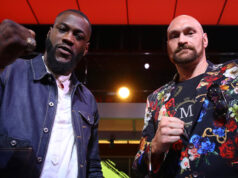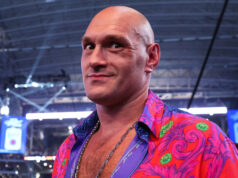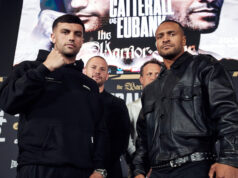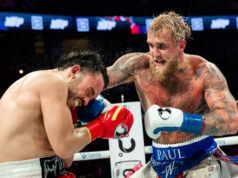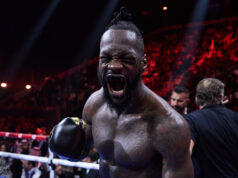It takes a pretty impressive being in order to justify changing a name legally to “marvelous”. That being was Marvin Hagler. Impressive he was. Hagler is seen by many fans and boxing historians alike to be among the best, if not THE best middleweight that has ever graced the ring. His moody demeanor and no nonsense attitude endeared him to America’s working class, fight loving demographic.
At the same time this made him an intimidating adversary to face, backed up by an astonishing seven year reign of terror over the world’s best challengers at middleweight, including notable victories over world champions such as John Mugabi and most memorably, Thomas Hearns. Marvin’s road to the top wasn’t as glorious as his championship run however and it was during this somewhat controversial and gritty period that Marvin earned his reputation as a blue-collar, “get the job done” fighter.
His ability to box just as well in either orthodox or southpaw stances added to his appeal and meant that he encompassed an added difficulty for opponents trying to figure him out. It gave him an extra versatility to exploit weaknesses in defense, switch-hitting when appropriate to confuse and take advantage of the opponent’s visible shortcomings, such as an exposed chin, or a hand that had just strayed too low too often.
The road to the middleweight world title left Hagler with a sizable chip on his shoulder. With the benefit of hindsight, it is hard to see why when it’s considered that the “Marvelous one” was one of the most successful champions in the divisions’ colorful history. Nonetheless, events beyond Hagler’s control slowed his progress somewhat and disallowed him to get to the top before he did.
After steadily and in many instances brutally dispatching his first 17 opponents, Marvin’s first smudge to a perfect record came against 1972 light–welterweight Olympic gold medalist and fringe middleweight title contender, Sugar Ray Seales, a man who never quite lived up to the legendary nickname bestowed upon him. They fought to a draw after Hagler had previously won a unanimous verdict. Marvin would later end Seale’s world title ambitions by crushing him in a maiden round technical Knockout, also winning their minor trilogy of fights with the win.
The Marvelous One’s career would later become synonymous with controversy, the main reason credited for Hagler’s attitude and desperate determination to remain on top for so long. The first disappointment for him came against Philadelphia slugger Bobby “Boogaloo” Watts. Despite the opinions of many favoring Hagler, who fought back valiantly from an early onslaught, the ringside judges awarded the contest to Watts. This verdict could conceivably have been due to home-town favoritism and meant that Marvin had to rebuild and reaffirm his status as a top middleweight contender.
The fighter’s apparent bad luck was later repeated just two fights later against Willie “The Worm” Monroe, although the latter’s victory was far clearer cut, with “the worm” picking up a unanimous ten round decision. This fight would signal a change for Hagler and the legendary champion would not taste defeat until his ultimate showdown with the returning Sugar Ray Leonard eleven years later. What distinguishes the length of this period from others is that The Marvelous One during this period would set about silencing all doubters to his dominance by knocking out every fighter that had caused an obstacle to his career.
Most notably in this list was former World champion Vito “The Mosquito” Antuofermo, who held responsibility for the delay of Hagler’s ascent to the middleweight throne by holding the challenger to a draw in 1979, meaning that Antuofermo retained the crown. This contest highlighted the later reasoning for Hagler’s reluctance to allow fights to go the distance; he feared a decision against him as had unfairly occurred against Watts and now in the fight that mattered, for the championship of the world. A symbol that would leave him with fewer doubters over his quality as a prize fighter.
Marvin’s greatness would begin against English champion Alan Minter at Wembley Arena on the 27th of September 1980. Fighting against a hugely hostile crowd, the challenger made sure that this time the three ringside judges were surplus to requirements. For three rounds, the challenger cleverly utilized his jab, a weapon that was known to tear flesh on account of the twisting motion Marvin adopted upon impact and did just that, burst the scar tissue of the less than thick skinned champion.
After 3 rounds of action in which Minter’s face had began to resemble something from a horror film, the referee, Carlos Berrocal, mercifully halted proceedings. Hagler was now King of the Hill, and would dodge no one in his quest to cement his legacy and put to bed his prejudices about the practices of the pugilistic world.
The newly installed champion took on all comers and quickly showed just why he was number one. Previous equal Antuofermo was this time destroyed in four, with William “Caveman” Lee failing to survive a full two minutes with the menacing champion. These defenses showcased ability that made Hagler truly special.
In some cases it set him apart from his contemporaries in the quartet of the fabulous four. Marvin showed that he would always remain patient, unlike most notably Thomas Hearns, when an opening appeared. There appeared to be a willingness from the champion to wait for the end to materialize rather than waste shots in a frenzy of urgency (as could be said of Hearns in the Cuevas fight. He threw non -stop at the end of the second.) The smart boxing combined with a fearsome will and controlled aggression made Hagler a truly scary fighter. The bald head and enduring scowl was capable of shaking the confidence of any man and meant that he was always capable of coming out with the win, having won the mental battle prior to the physical.
The fight that truly defines Marvelous Marvin Hagler took place on the 15th April 1985 at Caesars Palace, Las Vegas, Nevada. Never has there been a fight more documented for displays of sheer courage from both fighters, with an intensity set in the three rounds that it lasted that is more often than not, unable to be replicated in a full twelve/fifteen round championship fight. One boxing writer/historian describes the fight simply, as “three rounds of blood-curdling savagery.” These words do incredible justice to the magnitude of “The War.” Marvin Hagler-Middleweight champ, some would say pound for pound king, battled Thomas “Hitman” Hearns for the World Middleweight championship.
Hearns was reliant on at least one major fact, he had done what Hagler could not and had destroyed the Panamanian fighting machine Roberto Duran, whilst Hagler relied on boxing skill and unusually, the judges to enhance his record. However, past fortunes mean little in boxing, and Hagler backed this up, after weathering a frightful storm, initiated from his right hand, Hagler began to steadily take control when Hearns broke his hand from a powerful hook to the jaw of Hagler. Once again, familiarly, Hagler boxed for the opening. Pushed on by a cut to the forehead that threatened his reign, Hagler cut down an exhausted Hearns in the third, after boxing cleverly and exposing the light middleweight champion’s tiredness.
The outcome of the Hearns fight did nothing but good to Hagler’s already thriving reputation. He had struggled to the top and had stayed there on merit. He faced and battered the best, leaving little room for debate as to just how “Marvelous” he was. He could dominate from both stances, switching as if to tailor his style to the opponent. He could headhunt and destroy (as with Hearns). And he could play and win a physical chess match (as with Duran.) The man’s aura of invincibility seemed impregnable. Then along came Ray Leonard to spoil, controversially, the one man show.
Following the Hearns fight (which was voted the 1985 fight of the year and the 1st round subsequently voted the round of the decade) there were the inevitable clamors for a rematch. Hearn’s broken hand had meant that he could only offer limited resistance, though he never used the excuse of his injury to retract from the magnitude of the Marvelous One’s victory. It seemed as though the public would get its wish.
Cue Sugar Ray Leonard, fresh from an extended “retirement” and free to dictate terms, such was his stardom. Upon returning from his brief vacation from the sport, which was forced due to Leonard suffering a detached retina in a 1982 fight against Bruce Finch, Leonard fought and unconvincingly beat, limited journeyman Kevin Howard. The manner of the win, including suffering a knockdown, convinced him that his return was destined to be fruitless. Whilst Leonard could not make up his mind, Hagler persevered TKO’ing every viable challenger available.
Juan Roldan and Mustafa Hamsho made the mistake of trying to match Marvin; they fell to the great man. He did not appear to be slowing down, which made a Leonard clash, which had been whispered about ever since Hagler had brutally signalled the start of his reign in 1980 all the more attractive.
It had everything. A stylish boxer against a tough brooding champion. A man who had it all, America’s golden boy against the man who literally destroyed people and revelled in it, for everything he had. To make comparisons to Ali-Frazier a decade before would not be at all far from the mark.
Hagler’s last fight before the clash of the titans in 1987 served to set things up nicely for Marvelous Marvin. John Mugabi was his opponent, a tough Ugandan fighting under the guidance of British promoter Mickey Duff. Mugabi was an example that once again, as with the 11 defenses preceding him, Hagler failed to take the easy option, with Mugabi registering 26 KO’s in 26 professional starts. “The Beast” never backed down and matched Hagler punch for punch from the off.
He stared intently at Hagler at the end of the first, a theatrical act of defiance coupled with machismo. With Hagler opting to wear down the man opposite rather than throw heavy one-handers as the challenger preferred, he knocked out Mugabi in the seventh and chalked up another credible win. Hagler was now set up for the fall. Ray Leonard, watching from ringside had decided on the performance that he was ready to return in style, and defeat the “Marvelous One”. The challenge was issued, the announcements made, and the most anticipated fight of the decade, The Super Fight was ON.
The fight has the distinction of being probably the most highly debated spectacle that ever took place in the ring. Some favor Hagler, for his stalking aggressive approach and search and destroy tactics, whilst others favor Sugar Ray for his brief flashes of brilliance and ability to tame the monster champion for the whole 12 rounds. Whatever your opinion, what cannot be denied is the amount of intrigue that the fight at the time and since, has generated.
The fight was for bragging rights over everything else, for Hagler, a win meant the culmination of all the hard work, recognition as the sports best and a chance to erase all the bitter memories that had soured him on his career journey. For Leonard, the world could see that he was the sport’s successor to Ali, not just flash but true to his word, the added plaudits coming from the fact that an extended retirement had not dampened his skills.
Both men stood to make a fortune, With Leonard guaranteed $12 million as challenger with the champion receiving a larger sum of $12million to defend the title over twelve rounds, a distance Hagler and his trainers the Petronelli brothers never favored. Hagler held 12 round fights in contempt, claiming that true warriors fought for fifteen rounds. Hagler grew tired of the circus surrounding the fight and sometimes tried to avoid press conferences, preferring a camp of solitude that would allow his dislike of Leonard to fester and present itself in a terror that many previous challengers had to cope with in vain.
The fight itself was not what the talk surrounding it for years would suggest. Leonard fought with caution, back pedaling and reeling off occasional combinations that would appeal to the scoring judges at ringside. It was clear from the outset that Leonard was showing no willingness to stand and trade as others had done. Instead, the challenger used lateral movement to prevent a rhythm from being produced. Hagler continuously switched from orthodox to southpaw, which did nothing to confuse the challenger, who showed patience in sticking to a very pedestrian game plan, knowing that getting caught up in a brawl could prove fatal.
In my view, the negative tactics should have benefited Hagler on the scorecards. The champion was walking forward and always looking to push the action. When he managed to cut off the ring he tried to drag Leonard into his plan, with some success and making the bout more interesting to watch. Nevertheless, Leonard’s caution paid off and at the final bell, despite Hagler’s confident forecast of victory and his positive approach to proceedings, Leonard got the nod.
Two of the judges preferred the combination punching and keep away tactics of the challenger. With much protestation and a justified bitterness in the eyes of many, Hagler left the ring for good, twelve million dollars better off and certain that he would never fight again. The shining light of the middleweight division had now been extinguished, but what a turbulent ride it had been.
I would rate Marvin Hagler as the best fighter of the fabulous four era. He had so many dimensions. He could box with a smoothness that made southpaw look like the most common and effective stance. Playing the long game suited him, as with Duran, and he could call upon a quick finish when the occasion called for it, as with Hearns.
He was all business, and that is what defined the 80’s, with fighters such as Mike Tyson also plying their trade and reaching their pinnacles at this time. He oozed the type of fearsome aggression popularized by 1980s cinema with epics like Scarface, which made mean and moody cool. Marvin always rose to the challenge and he was truly deserving of his moniker, no apologies for this view, in the 80’s he truly was the Marvelous One.


